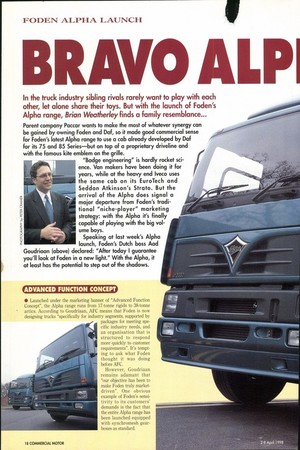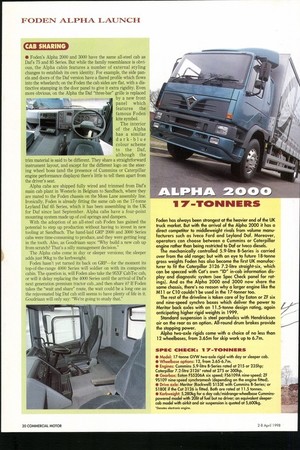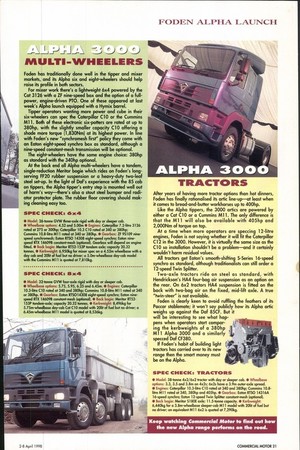BRAVO Al.1)1 In the truck industry sibling rivals rarely want
Page 20

Page 22

Page 23

If you've noticed an error in this article please click here to report it so we can fix it.
to play with each other, let alone share their toys. But with the launch of Foden's Alpha range, Brian Weatherley finds a family resemblance...
Parent company Paccar wants to make the most of whatever synergy can be gained by owning Foden and Daf, so it made good commercial sense for Foden's latest Alpha range to use a cab already developed by Daf for its 75 and 85 Series—but on top of a proprietary driveline and with the famous kite emblem on the grille.
"Badge engineering" is hardly rocket science. Van makers have been doing it for years, while at the heavy end Iveco uses the same cab on its EuroTech and Seddon Atkinson's Strato. But the arrival of the Alpha does signal a major departure from Foden's traditional "niche-player" marketing strategy: with the Alpha it's finally capable of playing with the big volume boys.
Speaking at last week's Alpha launch, Foden's Dutch boss Aad Goudriaan (above) declared: "After today I guarantee you'll look at Foden in a new light." With the Alpha, it at least has the potential to step out of the shadows.
ADVANCED FUNCTION CONCEPT However, Goudriaan remains adamant that "our objective has been to make Foden truly marketdriven". One obvious example of Foden's sensitivity to its customers' demands is the fact that the entire Alpha range has been launched equipped with synchromesh gearboxes as standard. CAB SHARING • Foden's Alpha 2000 and 3000 have the same all-steel cab as Dots 75 and 85 Series. But while the family resemblance is obvious, the Alpha cabin features a number of external styling changes to establish its own identity. For example, the side panels and doors of the Daf version have a flared profile which flows into the wheelarch; on the Foden the cab sides are flat, with a distinctive stamping in the door panel to give it extra rigidity. Even more obvious, on the Alpha the Daf "three-bar" grille is replaced by a new front panel which features the famous Foden kite symbol.
Alpha cabs are shipped fully wired and trimmed from Dafs main cab plant in Westerlo in Belgium to Sandbach, where they are mated to the Foden chassis on the Moss Lane assembly line. Ironically, Foden is already fitting the same cab on the 17-tonne Leyland Daf 65 Series, which it has been assembling in the UK for Daf since last September. Alpha cabs have a four-point mounting system made up of coil springs and dampers.
With the adoption of an all-steel cab Foden has gained the potential to step up production without having to invest in new tooling at Sandbach. The hand-laid GRP 2000 and 3000 Series cabs were time-consuming to produce, and they were getting long in the tooth. Also, as Goudriaan says: "Why build a new cab up from scratch? That's a silly management decision."
The Alpha cabs come in day or sleeper versions; the sleeper adds just 90kg to the kerbweight.
Foden hasn't yet turned its back on GRP—for the moment its top-of-the-range 4000 Series will soldier on with its composite cabin. The question is, will Foden also take the 95XF CabTec cab, or will it delay replacing the 4000 Series until the arrival of Dots next generation premium tractor cab...and then share it? If Foden takes the "wait and share" route, the wait could be a long one as the rejuvenated big Daf cab still seems to have plenty of life in it. Goudriaan will only say: "We're going to study that." 1 V-TONNERS Foden has always been strongest at the heavier end of the UK truck market. But with the arrival of the Alpha 2000 it has a direct competitor to middleweight rivals from volume manufacturers such as Iveco Ford and Leyland Daf. Moreover, operators can choose between a Cummins or Caterpillar engine rather than being restricted to Daf or Iveco diesels.
The mechanically controlled 5.9-litre B-Series is carried over from the old range; but with an eye to future 18-tonne gross weights Foden has also become the first UK manufacturer to fit the Caterpillar 3126 7.2-litre straight-six, which can be specced with Cat's own "ID" in-cab information display and diagnostic system (see Spec Check panel for ratings). And as the Alpha 2000 and 3000 now share the same chassis, there's no reason why a larger engine like the MI 1 or CIO couldn't be used in the 17-tonner too.
The rest of the driveline is taken care of by Eaton or ZF six and nine-speed synchro boxes which deliver the power to Mentor back axles with an 11.5-tonne design rating, again anticipating higher rigid weights in 1999.
Standard suspension is steel parabolics with Hendrickson air on the rear as an option. All-round drum brakes provide the stopping power.
Alpha two-axle rigids come with a choice of no less than 12 wheelbases, from 3.65m for skip work up to 6.7m.
SPEC CHECK: 1 7-TONNERS • Model: 17-tonne GVW two-axle rigid with day or sleeper cab. • Wheelbase options: 12, from 3.65-6.7m.
• Engines: Cummins 5.9-litre B-Series rated at 215 or 235hp; Caterpillar 7.2-litre 3126' rated at 275 or 300hp.
• Gearbox: Eaton FS5206A six speed; FS6109A nine-speed; ZF 95109 nine-speed synchromesh (depending on the engine fitted). • Drive axle: Mentor (Rockwell) 5153E with Cummins B-Series; or S180E if the Cat 3126 is fitted. Both are rated at 11.5 tonnes.
• Kerbweight: 5,280kg for a day cab/midrange-wheelbase Cumminspowered model with 201it of fuel but no driver; an equivalent sleepercab model with aid& and air suspension is quoted at 5,600kg.
*Denotes electronic engine. MULTI-WHEELERS Foden has traditionally done well in the tipper and mixer markets, and its Alpha six and eight-wheelers should help raise its profile in both sectors.
For mixer work there's a lightweight 6x4 powered by the Cat 3126 with a ZF nine-speed box and the option of a fullpower, engine-driven PTO. One of these appeared at last week's Alpha launch equipped with a Hymix barrel.
Tipper operators wanting more power and cube in their six-wheelers can spec the Caterpillar C10 or the Cummins M11. Both of these electronic six-potters are rated at up to 380hp, with the slightly smaller capacity C10 offering a shade more torque (1,830Nm) at its highest power. In line with Foden's new "synchromesh first" policy they come with an Eaton eight-speed synchro box as standard, although a nine-speed constant-mesh transmission will be optional.
The eight-wheelers have the same engine choice: 380hp as standard with the 340hp optional.
At the back end all Alpha multi-wheelers have a tandem, single-reduction Mentor bogie which rides on Foden's longserving FF20 rubber suspension or a heavy-duty two-leaf steel set-up. In the light of Daf's experience with the 85 cab on tippers, the Alpha tipper's entry step is mounted well out of harm's way—there's also a stout steel bumper and radiator protector plate. The rubber floor covering should making cleaning easy too.
SPEC CHECK: 452E4 • Model: 26-tonne GVW three-axle rigid with day or sleeper cab.
• Wheelbase options: 4.52 and 5.00m • Engines: Caterpillar 7.2-litre 3126 rated at 275 or 300hp; Caterpillar 10.3 C10 rated at 340 or 380hp; Cummins 10.8-litre MI1 rated at 340 or 380hp. • Gearbox: ZF 9S109 ninespeed synchromesh; Eaton RTSO 14308 eight-speed synchro; Eaton ninespeed RTX 14609B constant-mesh (optional). Gearbox will depend on engine fitted. • Back bogie: Mentor RT52-153P tandem axle; capacity 20.32 tonnes. • Kerbweight: 6,950kg for mixer spec on a 4.52m wheelbase with a day cab and 20lit of fuel but no driver; a 5.0m-wheelbase day-cab model with the Cummins MI1 is quoted at 7,810kg.
SPEC CHECK: B3cdt • Model: 32-tonne GVW four-axle rigid with day or sleeper cab.
• Wheelbase options: 5.75, 5.95, 6.25 and 6.45m. • Engines: Caterpillar 10.3-litre C10 rated at 340 and 380hp; Cummins 10.8-litre M11 rated at 340 or 380hp. • Gearbox: Eaton RTS014308 eight-speed synchro; Eaton ninespeed RTX 14609B constant-mesh (optional). • Back bogie: Mentor R152153P tandem-axle; capacity 20.32 tonnes. • Kerbweight: 8,496kg for 5.75m-wheelbase day-cab Cat CIO model with 201it of fuel but no driver; a 6.45m-wheelbase MI 1 model is quoted at 8,536kg. TRACTORS After years of having more tractor options than hot dinners, Foden has finally rationalised its artic line-up—at least when it comes to bread-and-butter workhorses up to 400hp.
Like the Alpha tippers, the 3000 artics are powered by either a Cat C10 or a Cummins M11. The only difference is that the MI I will also be available with 405hp and 2,000Nm of torque on tap.
At a time when more operators are speccing 12-litre engines, Foden is not saying whether it will fit the Caterpillar C12 in the 3000. However, it is virtually the same size as the C10 so installation shouldn't be a problem—and it certainly wouldn't harm residual values.
All tractors get Eaton's smooth-shifting S-Series 16-speed synchro as standard, although traditionalists can still order a 12-speed Twin Splitter.
Two-axle tractors ride on steel as standard, with Hendrickson's HA4 four-bag air suspension as an option on the rear. On 6x2 tractors HA4 suspension is fitted on the back with two-bag air on the fixed, mid-lift axle. A true "twin-steer" is not available.
Foden is clearly keen to avoid ruffling the feathers of its Paccar stablemate; it won't say publicly how its Alpha artic weighs up against the Daf 85CF. But it will be interesting to see what hap pens when operators start compar-r-; ; ing the kerbweights of a 380hp II' M11 Alpha 3000 and a similarly b. specced Daf CF380.
If Foden's habit of building light tractors has carried over to its new range then the smart money must be on the Alpha.
SPEC CHECK:: TRACTORS • Model: 38-tonne 4x2/6x2 tractor with day or sleeper cab. • Wheelbase options: 3.3, 3.5 and 3.8m on 4x2s; 6x2s have a 3.9m outer-axle spread.
• Engines: Caterpillar 10.3-litre CIO rated at 340 and 380hp; Cummins 10.8litre M11 rated at 340, 380hp and 405hp. • Gearbox: Eaton RTSO 14316A 16-speed synchro; Eaton 12-speed Twin Splitter constant-mesh (optional).
• Back bogie: Mentor S180E axle; 11.5-tonne capacity. • Kerbweight: 6,440kg for a 3.8m-wheelbase sleeper-cab M11 model with 201it of fuel but no driver; an equivalent M11 6x2 is quoted at 7,290kg.
























































































































